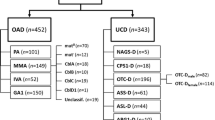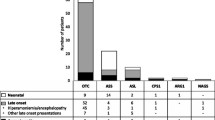Summary
Objectives Isolated methylmalonic acidurias (MMAurias) are caused by deficiency of methylmalonyl-CoA mutase or by defects in the synthesis of its cofactor 5′-deoxyadenosylcobalamin. The aim of this study was to evaluate which parameters best predicted the long-term outcome. Methods Standardized questionnaires were sent to 20 European metabolic centres asking for age at diagnosis, birth decade, diagnostic work-up, cobalamin responsiveness, enzymatic subgroup (mut0, mut−, cblA, cblB) and different aspects of long-term outcome. Results 273 patients were included. Neonatal onset of the disease was associated with increased mortality rate, high frequency of developmental delay, and severe handicap. Cobalamin non-responsive patients with neonatal onset born in the 1970s and 1980s had a particularly poor outcome. A more favourable outcome was found in patients with late onset of symptoms, especially when cobalamin responsive or classified as mut−. Prevention of neonatal crises in pre-symptomatically diagnosed newborns was identified as a protective factor concerning handicap. Chronic renal failure manifested earlier in mut0 patients than in other enzymatic subgroups. Conclusion Outcome in MMAurias is best predicted by the enzymatic subgroup, cobalamin responsiveness, age at onset and birth decade. The prognosis is still unfavourable in patients with neonatal metabolic crises and non-responsiveness to cobalamin, in particular mut0 patients.





Similar content being viewed by others
Abbreviations
- cblA:
-
methylmalonic aciduria cblA type
- cblB:
-
methylmalonic aciduria cblB type
- cblC:
-
methylmalonic aciduria and homocystinuria, cblC type
- cblD:
-
methylmalonic aciduria and homocystinuria, cblD type
- cblF:
-
methylmalonic aciduria cblF type
- CRF:
-
chronic renal failure
- GFR:
-
glomerular filtration rate
- LRT:
-
likelihood ratio test
- MCM:
-
methylmalonyl-CoA mutase
- MMA:
-
methylmalonic acid
- MMAurias:
-
methylmalonic acidurias
- mut0 :
-
complete defect of methylmalonyl-CoA-mutase activity
- mut− :
-
partial defect of methylmalonyl-CoA-mutase activity
References
Agresti A. Categorical Data. 2nd edn. New York: Wiley, 2002.
Aquaviva C, Benoist JF, Perwira S, et al (2005) Molecular basis of methylmalonyl CoA mutase apoenzyme defect in 40 European patients affected by mut0 and mut− forms of methylmalonic acidemia: identification of 29 novel mutations in the MUT gene. Hum Mutat 25: 167–176.
Baumgartner ER, Giardini O, Cantani A (1982) Methylmalonic acidemia due to apoenzyme defect: responsive to vitamin B12 in intact fibroblasts but not in vivo. J Inherit Metab Dis 5: 137–141.
Baumgartner ER, Viardot C (1995) Long-term follow-up of 77 patients with isolated methylmalonic aciduria. J Inherit Metab Dis 18: 138–142.
Coelho D, Suormala T, Stucki M, et al (2008) Gene identification for the cblD defect of vitamin B12 metabolism. N Engl J Med 358: 1454–1564.
Deodato F, Boenzi S, Santorelli FM, Dionisi-Vici C (2006) Methylmalonic and propionic aciduria. Am J Med Genet Semin Med Genet 142C: 104–112.
Dionisi-Vici C, Deodato F, Röschinger W, Rhead W, Wilcken B (2006) Classical organic acidurias, propionic aciduria, methylmalonic aciduria and isovaleric aciduria: Long-term outcome and effects of expanded newborn screening using tandem mass spectrometry. J Inherit Metab Dis 29: 383–389.
Fenton WA, Gravel RA, Rosenblatt DS (2001) Disorders of propionate and methylmalonate metabolism. In: Scriver CR, Beaudet AL, Sly WS, Valle D, eds; Childs B, Kinzler KW, Vogelstein B, assoc. eds. The Metabolic and Molecular Bases of Inherited Disease, 8th edn. New York: McGraw-Hill, 2165–2193.
Fowler B, Leonard JV, Baumgartner MR (2008) Causes of and diagnostic approach to methylmalonic acidurias. J Inherit Metab Dis 31: 350–360.
Hörster F, Baumgartner MR, Viardot C, et al. (2007) Long-term outcome in methylmalonic acidurias is influenced by the underlying defect (mut0, mut−, cblA, cblB). Pediatr Res 62: 225–230.
Hothorn T, Hornik K, Zeileis A (2006) Unbiased recursive partitioning: a conditional inference framework. J Comput Graph Stat 15: 651–674.
Kölker S, Garbade SF, Boy N, et al (2007) Decline of acute encephalopathic crises in children with glutaryl-CoA dehydrogenase deficiency identified by newborn screening in Germany. Pediatr Res 62: 357–363.
Lempp TJ, Suormala T, Siegenthaler R, et al (2006) Mutation and biochemical analysis of 19 probands with mut0 and mut− methylmalonic aciduria: identification of seven novel mutations. Mol Genet Metab 90: 284–290.
Leonard JV, Vijayaraghavan S, Walter JH (2003) The impact of screening for propionic and methylmalonic acidaemia. Eur J Pediatr 162 (Supplement 1): S21–S24.
Lindner M, Ho S, Kölker S, Abdoh G, Hoffmann GF, Burgard P (2008) Newborn screening for methylmalonic acidurias—optimization by statistical parameter combination. J Inherit Metab Dis 31: 379–385.
Matsui SM, Mahoney MJ, Rosenberg LE (1983) The natural history of the inherited methylmalonic acidemias. N Engl J Med 308: 857–861.
Nicolaides P, Leonard JV, Surtees R (1998) The neurological outcome of methylmalonic acidaemia. Arch Dis Child 78: 508–512.
Ogier de Baulny H, Benoist JF, Rigal O, Touati G, Rabier D, Saudubray JM (2005) Methylmalonic and propionic acidaemias: management and outcome. J Inherit Metab Dis 28: 415–423.
R Development Core Team (2008). R: A language and environment for statistical computing. Vienna: R Foundation for Statistical Computing (URL http://www.R-project.org). ISBN 3-900051-07-0.
Shevell MI, Matiaszuk N, Ledley FD, Rosenblatt DS (1993) Varying neurological phenotypes among mut0 and mut− patients with methylmalonylCoA mutase deficiency. Am J Med Genet 45: 619–624.
Touati G, Valayannopoulos V; Mention K, et al (2006) Methylmalonic and propionic acidurias: management without or with a few supplements of specific amino acid mixture. J Inherit Metab Dis 29: 288–298.
Van der Meer SB, Poggi F, Spada M, et al. (1994) Clinical outcome of long-term management of patients with vitamin B12-unresponsive methylmalonic acidemia. J Pediatr 125: 903–908.
Venables WN, Ripley BD. Modern Applied Statistics with S. 4th edn. New York: Springer, 2002.
Wilcken B, Wiley V, Hammond J, Carpenter K (2003) Screening newborns for inborn errors of metabolism by tandem mass spectrometry. N Engl J Med 348(23): 2304–2312.
Worgan LC, Niles K, Tirone JC, et al (2006) Spectrum of mutations in mut methylmalonic acidemia and identification of a common Hispanic mutation and haplotype. Hum Mutat 27: 31–43.
Zwickler T, Lindner M, Aydin HI, et al (2008) Diagnostic work-up and management of patients with isolated methylmalonic acidurias in European metabolic centres. J Inherit Metab Dis 31: 361–367.
Acknowledgement
The authors thank Silvia Körner for excellent technical assistance in preparing the questionnaire, METABNET for organizational support, and A Bartuli, B König, D Möslinger, S Picca, U Wendel and M Williams for providing clinical information on their patients. We gratefully acknowledge Milupa Metabolics for sponsoring the 1st International Workshop on Methylmalonic Acidurias (25–27 October 2006 in Heidelberg).
Author information
Authors and Affiliations
Corresponding author
Additional information
Communicating editor: Ertan Mayatepek
Competing interests: None declared
References to electronic databases: Methylmalonic aciduria, cblA type: OMIM 251100. Methylmalonic aciduria, cblB type: OMIM 251110. Methylmalonic aciduria and homocystinuria, cblC type: OMIM 277400. Methylmalonic aciduria and homocystinuria, cblD type: OMIM 277410. Methylmalonic aciduria, cblF type, OMIM 277380. Complete defect of methylmalonyl-CoA-mutase activity, mut0: OMIM 251000. Partial defect of methylmalonyl-CoA-mutase activity, mut−: OMIM 251000. Methylmalonyl-CoA mutase: EC 5.4.99.2.
An erratum to this article can be found at http://dx.doi.org/10.1007/s10545-009-9957-x
Electronic supplementary material
Below is the link to the electronic supplementary material
Table S1
List of participating metabolic centres (DOC 39.5 KB).
Rights and permissions
About this article
Cite this article
Hörster, F., Garbade, S.F., Zwickler, T. et al. Prediction of outcome in isolated methylmalonic acidurias: combined use of clinical and biochemical parameters. J Inherit Metab Dis 32, 630–639 (2009). https://doi.org/10.1007/s10545-009-1189-6
Received:
Revised:
Accepted:
Published:
Issue Date:
DOI: https://doi.org/10.1007/s10545-009-1189-6




